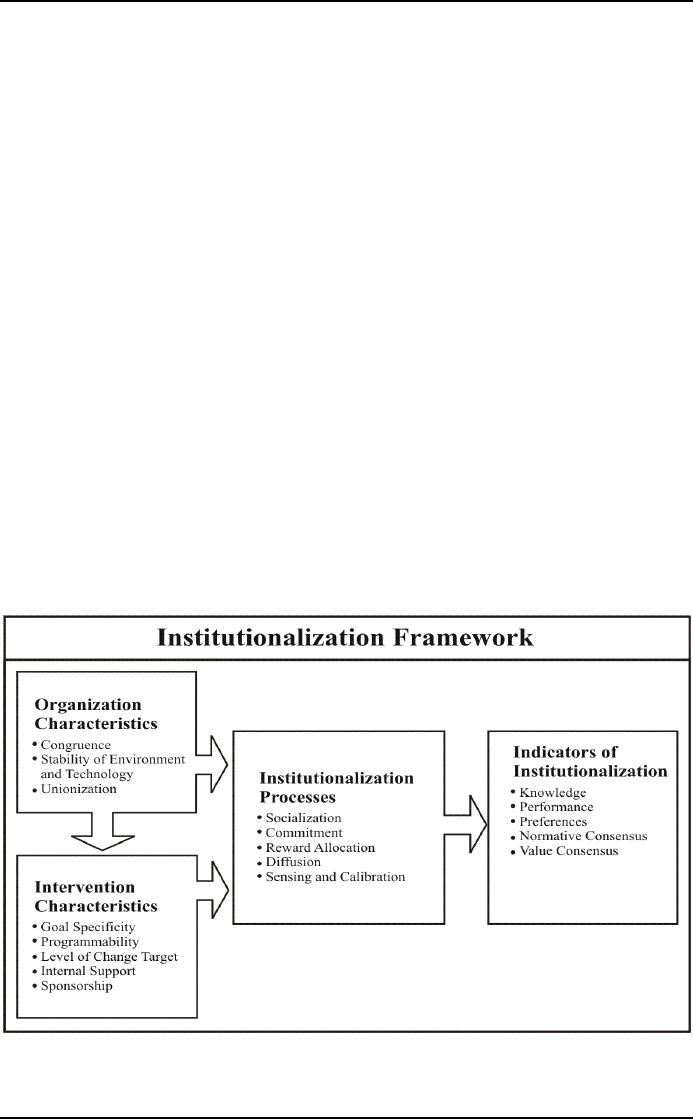 |

Organization
Development MGMT
628
VU
Lesson
27
Evaluating
and Institutionalizing Organization
Development Interventions
Institutionalizing
interventions:
Once
it is determined that a change has
been implemented and is effective,
attention is directed at
institutionalizing
the changes--making them a permanent part of the
organization's normal functioning.
Lewin
described change as occurring in three
stages: unfreezing, moving, and
refreezing. Institutionalizing
an
OD intervention concerns refreezing. It
involves the long-term persistence of organizational
changes: to
the
extent that changes persist, they
can be said to be institutionalized.
Such changes are not
dependent on
any
one person but exist as a
part of the culture of an organization. This means
that numerous others
share
norms
about the appropriateness of the
changes.
How
planned changes become institutionalized
has not received much
attention in the OD literature.
Rapidly
changing environments have led to admonitions
from consultants and practitioners to
"change
constantly,"
to "change before you have
to," and "if it's not broke,
fix it anyway." Such a context
has
challenged
the utility of the institutionalization
concept. Why endeavor to make
any change permanent
given
that it may require changing
again soon? However, the admonitions
also have resulted in
institutionalization
concepts being applied in new ways.
Change itself has become the
focus of
institutionalization.
Total quality management, organization
learning, integrated strategic change,
and self-
design
interventions all are aimed
at enhancing the organization's capability for
change. In this vein,
processes
of institutionalization take on increased
utility. This section
presents a framework identifying
factors
and processes that
contribute to the institutionalization of OD
interventions, including the
process
of
change itself.
Institutionalization
Framework:
Figure
37 presents a framework that identifies
organization and intervention
characteristics and
institutionalization
processes affecting the degree to which
change programs are
institutionalized. The
model
shows that two key
antecedents--organization and intervention
characteristics--affect different
institutionalization
processes operating in organizations.
These processes, in turn, affect
various indicators
of
institutionalization. The model also
shows that organization characteristics
can influence intervention
characteristics.
For example, organizations having
powerful unions may have
trouble gaining internal
support
for OD interventions.
Figure
37: Institutionalization
Framework
Organization
Characteristics:
Figure
37 show that the following
three key dimensions of an organization
can affect intervention
characteristics
and institutionalization
processes.

Organization
Development MGMT
628
VU
1.
Congruence. This
is the degree to which an intervention is
perceived as being in harmony with
the
organization's
managerial philosophy, strategy,
and structure; its current
environment; and other
changes
taking
place. When an intervention is congruent
with these dimensions, the
probability is improved that
it
will
be institutionalized. Congruence can
facilitate persistence by making it easier to
gain member
commitment
to the intervention and to diffuse it to
wider segments of the organization. The
converse also
is
true; many OD interventions promote
employee participation and
growth. When applied in
highly
bureaucratic
organizations with formalized structures
and autocratic managerial
styles, participative
interventions
are not perceived as congruent
with the organization's managerial
philosophy.
2.
Stability
of environment and technology: This
involves the degree to which the
organization's
environment
and technology are changing.
Unless the change target is
buffered from these changes
or
unless
the changes are dealt with
directly by the change program, it may be
difficult to achieve
long-term
intervention
stability. For example,
decreased demand for the
firm's products or services can
lead to
reductions
in personnel that may change
the composition of the groups involved in
the intervention.
Conversely,
increased product demand can
curtail institutionalization by bringing
new members on board
at
a rate faster than they can be
socialized effectively.
3.
Unionization.
Diffusion of interventions may be
more difficult in unionized
settings, especially if the
changes
affect union contract issues, such as
salary and fringe benefits,
ob design, and employee
flexibility.
For
example, a rigid union
contract can make it
difficult to merge several
job classifications into
one, as
might
be required to increase task variety in a
job enrichment program. It is important
to emphasize,
however,
that unions can be a powerful force
for promoting change, particularly
when a good relationship
exists
between union and
management.
Intervention
characteristics:
Figure
37 shows that the following
five major features of OD interventions
can affect institutionalization
processes:
1.
Goal
specificity. This involves the
extent to which intervention goals
are specific rather than
broad.
Specificity
of goals helps direct socializing
activities (for example. training
and orienting new members)
to
particular
behaviors required to implement the intervention. It
also helps operationalize the new
behaviors
so
that rewards can be linked
clearly to them. For
example, an intervention aimed
only at increasing
product
quality is likely to be more
focused and readily put into
operation than a change program
intended
to
improve quality, quantity,
safety, absenteeism, and
employee development.
2.
Programmability. This
involves the degree to which the changes
can be programmed or the extent to
which
the different intervention
characteristics can be specified
clearly in advance to enable
socialization,
commitment,
and reward allocation. For
example, job enrichment specifies
three targets of
change:
employee
discretion, task variety, and
feedback. The change program
can be planned and designed
to
promote
those specific
features.
3.
Level
of change target. This
concerns the extent to which the change
target is the total organization,
rather
than a department or small work group.
Each level of organization has facilitators
and inhibitors of
persistence.
Departmental and group changes
are susceptible to countervailing
forces from others in
the
organization.
These can reduce the
diffusion of the intervention and
lower its ability to impact
organization
effectiveness.
However, this does not
preclude institutionalizing the change
within a department that
successfully
insulates itself from the
rest of the organization. Such insulation
often manifests itself as
a
subculture
within the organization.
Targeting
the intervention to wider segments of the
organization, on the other hand, also
can help or
hinder
change persistence. A shared
belief about the intervention's value
can be a powerful incentive to
maintain
the change, and promoting a
consensus across organizational
departments exposed to the
change
can
facilitate institutionalization. But targeting the
larger system also can
inhibit institutionalization.
The
intervention
can become mired in political
resistance because of the "not
invented here" syndrome
or
because
powerful constituencies oppose
it.
4.
Internal
support. This
refers to the degree to which
there is an internal support system to
guide the
change
process. Internal support, typically
provided by an internal consultant,
can gain commitment for
the
changes
and help organization members implement
them. External consultants
also can provide
support,
especially
on a temporary basis during the early
stages of implementation. For example, in
many
interventions
aimed at implementing high--involvement
organizations, both external and
internal
consultants
provide change support. The external
consultant typically brings expertise on
organizational
design
and trains members to implement the
design. The internal consultant
generally helps members
relate
to
other organizational units, resolve conflicts
and legitimize the change activities
within the organization.
5.
Sponsorship. This
concerns the presence of a powerful
sponsor who can initiate,
allocate, and
legitimize
resources for the intervention.
Sponsors must come from
levels in the organization high
enough

Organization
Development MGMT
628
VU
to
control appropriate resources, and they
must have the visibility and
power to nurture the intervention
and
see that it remains viable. There
are many examples of OD
interventions that persisted
for several years
and
then collapsed abruptly when the
sponsor, usually a top administrator,
left the organization. There also
are
numerous examples of middle
managers withdrawing support for
interventions because
top
management
did not include them in the change
program.
Institutionalization
Processes:
The
framework depicted in Figure 37 shows the
following five institutionalization
processes that can
directly
affect the degree to which OD
interventions are
institutionalized.
1.
Socialization. This
concerns the transmission of information
about beliefs, preferences, norms,
and
values
with respect to the intervention.
Because implementation of OD
interventions generally involves
considerable
learning and experimentation, a continual
process of socialization is necessary to
promote
persistence
of the change program. Organization
members must focus attention
on the evolving nature of
the
intervention and its ongoing
meaning. They must communicate this
information to other
employees,
especially
new members. Transmission of
information about the intervention helps
bring new members
onboard
and allows participants to reaffirm the
beliefs, norms, and values
underlying the intervention.
For
example,
employee involvement programs
often include initial transmission of
information about the
intervention,
as well as retraining of existing participants
and training of new members.
Such processes are
intended
to promote persistence of the program as
both new behaviors are
learned and new members
are
introduced.
2.
Commitment. This binds people
to behaviors associated with the
intervention. It includes
initial
commitment
to the program, as well as recommitment over time.
Opportunities for commitment
should
allow
people to select the necessary behaviors
freely, explicitly, and
publicly. These conditions
favor high
commitment
and can promote stability of
the new behaviors. Commitment should derive
from several
organizational
levels, including the employees
directly involved and the
middle and upper managers
who
can
support or thwart the intervention. In
many early employee
involvement programs, for
example,
attention
was directed at gaining workers' commitment to
such programs. Unfortunately,
middle managers
were
often ignored and considerable
management resistance to the
interventions resulted.
3.
Reward
allocation. This
involves linking rewards to the new
behaviors required by an
intervention.
Organizational
rewards can enhance the
persistence of interventions in at least
two ways. First, a
combination
of intrinsic and extrinsic rewards
can reinforce new behaviors.
Intrinsic rewards are
internal
and
derive from the opportunities for
challenge, development, and
accomplishment found in the
work.
When
interventions provide these
opportunities, motivation to perform
should persist. This behavior
can
be
further reinforced by providing extrinsic
rewards, such as money, for
increased contributions.
Because
the
value of extrinsic rewards tends to
diminish over time, it may be
necessary to revise the reward
system
to
maintain high levels of desired
behaviors.
Second,
new behaviors will persist
to the extent that rewards are
perceived as equitable by
employees.
When
new behaviors are fairly
compensated. People are
likely to develop preferences for
those behaviors.
Over
time, those preferences should lead to
normative and value
consensus about the appropriateness
of
the
intervention. For example,
many employee involvement
programs fail to persist
because employees feel
that
their increased contributions to
organizational improvements are unfairly
rewarded. This is especially
true
for interventions relying
exclusively on intrinsic rewards.
People argue that an
intervention that
provides
opportunities for intrinsic
rewards also should provide
greater pay or extrinsic rewards
for higher
levels
of contribution to the organization.
4.
Diffusion. This
refers to the process of transferring
interventions from one
system to another.
Diffusion
facilitates
institutionalization by providing a wider
organizational base to support the new
behaviors. Many
interventions
fail to persist because they
run counter to the values and
norms of the larger organization.
Rather
than support the intervention, the
larger organization rejects the changes
and often puts pressure
on
the
change target to revert to old
behaviors. Diffusion of the intervention
to other organizational units
reduces
this counter implementation force. It tends to
lock in behaviors by providing
normative consensus
from
other parts of the organization.
Moreover, the act of transmitting
institutionalized behaviors to
other
systems
reinforces commitment to the
changes.
5.
Sensing
and calibration. This
involves detecting deviations from
desired intervention behaviors
and
taking
corrective action, institutionalized behaviors
invariably encounter destabilizing forces,
such as
changes
in the environment, new technologies,
and pressures from other
departments to nullify
changes.
These
factors cause some variation
in performances preferences norms,
and values. To detect this
variation
and
take corrective actions, organizations
must have some sensing
mechanism. Sensing mechanisms,
such
as
implementation feedback, provide
information about the occurrence of
deviations. This knowledge can
then
initiate corrective actions to ensure
that behaviors are more in
line with the intervention.
For example,
if
a high level of job discretion associated
with a job enrichment intervention
does not persist,
information

Organization
Development MGMT
628
VU
about
this problem might initiate' corrective
actions, such as renewed
attempts to socialize people or to
gain
commitment to the intervention.
Indicators
of Institutionalization:
Institutionalization
is not an all-or-nothing concept
but reflects degrees of
persistence of an intervention.
Figure
37 shows five indicators of the extent of an
intervention's persistence. The extent to
which the
following
factors arc present or
absent: indicates the degree of
Institutionalization
1.
Knowledge. This
involves the extent to which organization
members have knowledge of the
behaviors
associated
with an intervention, it is concerned
with whether members know enough to
perform the
behaviors
and to recognize the consequences of
that performance. For
example, job enrichment includes
a
number
of new behaviors, such as
performing a greater variety of tasks,
analyzing information about
task
performance,
and making decisions about
work methods and
plans.
2.
Performance. This is
concerned with the degree to
which intervention behaviors
are actually performed.
It
may be measured by counting the
proportion of relevant people performing the
behaviors. For
example,
60
percent of the employees in a particular
work unit might be
performing the job enrichment
behaviors
described
above. Another measure of
performance is the frequency with
which the new behaviors
are
performed.
In assessing frequency, it is important to
account for different variations of the
same essential
behavior,
as well as highly institutionalized
behaviors that need to be
performed only
infrequently.
3.
Preferences. This
involves the degree to which organization
members privately accept the
organizational
changes.
This contrasts with acceptance
based primarily organizational sanctions
or group pressures.
Private
acceptance usually is reflected in
people's positive attitudes
toward the changes and can
be
measured
by the direction and intensity of
those attitudes across the
members of the work unit
receiving
the
intervention. For example, a
questionnaire assessing members'
perceptions of a job enrichment
program
might show that most
employees have a strong
positive attitude toward making
decisions,
analyzing
feedback, and performing a variety of
tasks.
4.
Normative
consensus. This
focuses on the extent to which people
agree about the appropriateness
of
the
organizational changes. This indicator of
institutionalization reflects how
fully changes have
become
part
of the normative structure of the organization.
Changes persist to the degree
members feel that they
should
support them. For example, a
job enrichment program would become
institutionalized to the extent
that
employees support it and see it as appropriate to
organizational functioning.
5.
Value
consensus. This is
concerned with social
consensus on values relevant to the
organizational
changes.
Values are beliefs about how people
ought or ought not to
behave. They are
abstractions from
more
specific norms. Job enrichment,
for example, is based on
values promoting employee
self-control and
responsibility.
Different behaviors associated
with job enrichment, such as making
decision and
performing
a
variety of tasks, would persist to the
extent that employees widely
share values of self-control
and
responsibility.
These
five indicators can be used to
assess the level of institutionalization of an OD
intervention. The
more
the indicators are present in a situation, the higher
will be the degree of
institutionalization. Further;
these
factors seem to follow a
specific development order: knowledge, performance,
preferences, norms,
and
values. People must first
understand flew behaviors or
changes before they can perform
them
effectively.
Such performance generates
rewards and punishments,
which in time affect people's
preferences.
As many individuals come to
prefer the changes, normative
consensus about their
appropriateness
develops. Finally, if there is
normative agreement about the changes
reflecting a particular
set
of values, over time there should be
some consensus on those
values among organization
members.
Given
this developmental view of institutionalization, it is
implicit that whenever one
of the last indicators
is
present, all the previous ones
are automatically included as well. For
example, if employees
normatively
agree
with the behaviors associated
with job enrichment, then they
also have knowledge about the
behaviors,
can perform them effectively,
and prefer them. An OD
intervention is fully institutionalized
only
when
all five factors are
present.
Table of Contents:
- The Challenge for Organizations:The Growth and Relevance of OD
- OD: A Unique Change Strategy:OD consultants utilize a behavioral science base
- What an “ideal” effective, healthy organization would look like?:
- The Evolution of OD:Laboratory Training, Likert Scale, Scoring and analysis,
- The Evolution of OD:Participative Management, Quality of Work Life, Strategic Change
- The Organization Culture:Adjustment to Cultural Norms, Psychological Contracts
- The Nature of Planned Change:Lewin’s Change Model, Case Example: British Airways
- Action Research Model:Termination of the OD Effort, Phases not Steps
- General Model of Planned Change:Entering and Contracting, Magnitude of Change
- The Organization Development Practitioner:External and Internal Practitioners
- Creating a Climate for Change:The Stabilizer Style, The Analyzer Style
- OD Practitioner Skills and Activities:Consultant’s Abilities, Marginality
- Professional Values:Professional Ethics, Ethical Dilemmas, Technical Ineptness
- Entering and Contracting:Clarifying the Organizational Issue, Selecting an OD Practitioner
- Diagnosing Organizations:The Process, The Performance Gap, The Interview Data
- Organization as Open Systems:Equifinality, Diagnosing Organizational Systems
- Diagnosing Organizations:Outputs, Alignment, Analysis
- Diagnosing Groups and Jobs:Design Components, Outputs
- Diagnosing Groups and Jobs:Design Components, Fits
- Collecting and Analyzing Diagnostic information:Methods for Collecting Data, Observations
- Collecting and Analyzing Diagnostic information:Sampling, The Analysis of Data
- Designing Interventions:Readiness for Change, Techno-structural Interventions
- Leading and Managing Change:Motivating Change, The Life Cycle of Resistance to Change
- Leading and managing change:Describing the Core Ideology, Commitment Planning
- Evaluating and Institutionalizing Organization Development Interventions:Measurement
- Evaluating and Institutionalizing Organization Development Interventions:Research Design
- Evaluating and Institutionalizing Organization Development Interventions
- Interpersonal and Group Process Approaches:Group Process
- Interpersonal and Group Process Approaches:Leadership and Authority, Group Interventions
- Interpersonal and Group Process Approaches:Third-Party Interventions
- Interpersonal and Group Process Approaches:Team Building, Team Building Process
- Interpersonal and Group Process Approaches:Team Management Styles
- Organization Process Approaches:Application Stages, Microcosm Groups
- Restructuring Organizations:Structural Design, Process-Based Structures
- Restructuring Organizations:Downsizing, Application Stages, Reengineering
- Employee Involvement:Parallel Structures, Multiple-level committees
- Employee Involvement:Quality Circles, Total Quality Management
- Work Design:The Engineering Approach, Individual Differences, Vertical Loading
- Performance Management:Goal Setting, Management by Objectives, Criticism of MBO
- Developing and Assisting Members:Career Stages, Career Planning, Job Pathing
- Developing and Assisting Members:Culture and Values, Employee Assistance Programs
- Organization and Environment Relationships:Environmental Dimensions, Administrative Responses
- Organization Transformation:Sharing the Vision, Three kinds of Interventions
- The Behavioral Approach:The Deep Assumptions Approach
- Seven Practices of Successful Organizations:Training, Sharing Information